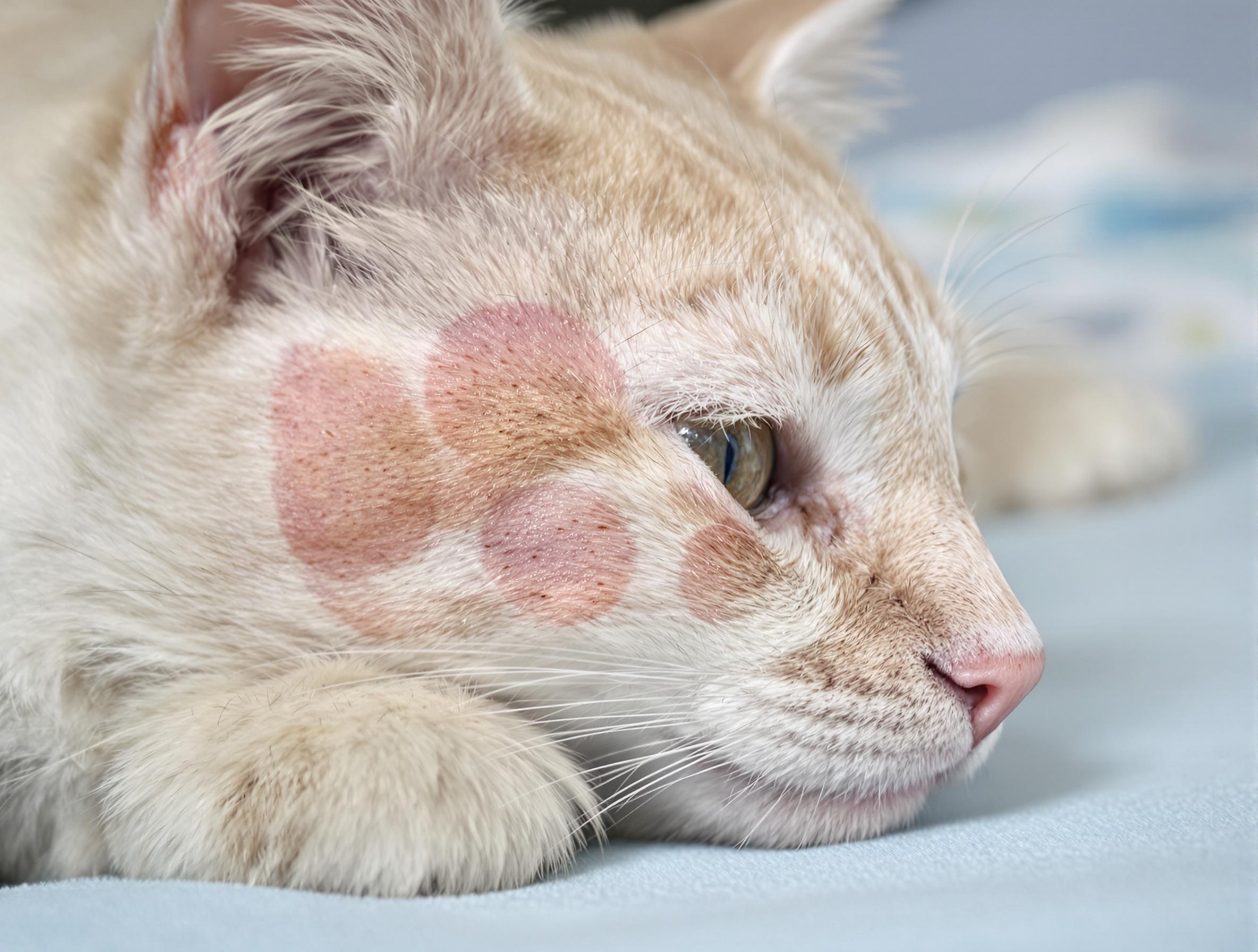Surprising Cat Health Problems Fleas Can Cause

Key takeaways:
- Fleas can cause severe health problems for your cat, including allergic reactions, anemia, and transmission of tapeworms.
- Consistent flea prevention is critical to safeguarding your cat’s health, especially for kittens and senior cats who are more vulnerable.
- Early detection and treatment are essential for managing complications like flea allergy dermatitis and skin infections.
- Your vet is your best source of flea prevention and treatment advice.
Let’s talk a little about that word most cat owners dread: fleas. Fleas are a common problem, but they can still pose risks to your cat’s overall health, including allergic reactions, anemia, and disease transmission. In this article, we’ll explore seven health problems fleas can cause in cats and how to prevent them effectively.
If you’re concerned about fleas or your cat’s condition, reach out to your veterinary professional right away for a consultation and treatment.
How flea infestations impact feline well-being

Fleas are an inconvenience for you, but they can disrupt the comfort and overall health of your cat in surprising ways. One reason for this is that fleas can feed on your cat’s blood up to 15 times a day, draining vital nutrients and exposing them to a host of potential diseases and infections. Here are the most common issues to be aware of.
Understanding flea allergy dermatitis in cats
Flea allergy dermatitis (FAD) happens when your cat develops an allergic response to flea saliva. While many cats experience discomfort from flea bites, cats with FAD suffer an intensified reaction that can impact their quality of life.
Your cat might be dealing with FAD if you notice them intensely scratching or overgrooming, particularly at the base of their tail, neck, or the top of the head. Watch for these early warning signs:
- hair loss
- skin redness
- small scabs
Quick action can prevent these symptoms from progressing into more serious skin problems. The good news is that with proper flea prevention and early veterinary care, cats with FAD can live comfortable, happy lives.
Recognizing anemia from flea infestations
When fleas feed on your cat, they can cause anemia, a drop in healthy red blood cells that carry oxygen through the body. Kittens and senior cats are particularly vulnerable to blood loss from flea bites. Their smaller bodies and weaker immune systems make them less able to replace lost blood cells.
The signs of flea-related anemia in your cat should be quite easy to spot:
- Pale or white gums instead of healthy pink coloring
- Sleepiness or lack of interest in playtime
- Decreased appetite or refusing favorite treats
- Cool ears and paws to the touch
- Fast breathing, especially during rest
A simple way to check your cat’s gums is to gently press them with your finger—they should return to pink within two seconds.
Tapeworm infections linked to fleas
Tapeworms in cats from fleas are a common but preventable health problem. When cats groom themselves, they might understandably swallow infected fleas carrying Dipylidium caninum, the most common tapeworm species affecting cats. These parasites can grow up to 28 inches long in your cat’s intestines, causing lethargy, weight loss, and digestive issues.
Keep an eye out for small, rice-like segments around your cat’s rear end or in their bedding—these are telltale signs of infection. A combination of monthly flea prevention and regular deworming every three months provides effective protection for your cat. Your veterinarian can prescribe safe, simple treatments to eliminate existing tapeworms and prevent future infections.
Fleas contributing to skin infections
When your cat scratches intensely due to flea bites, their claws can break the skin and create small wounds. These openings become perfect entry points for bacteria, which could lead to painful skin infections. The constant scratching and grooming can cause hot spots (moist, inflamed skin lesions)—raw, infected areas that require immediate veterinary care.
To protect your cat’s skin health and prevent infections from fleas, start with a multi-pronged approach:
- Combine monthly topical treatments with regular home cleaning to break the flea life cycle.
- Pay attention to your cat’s grooming habits, especially around their neck, base of tail, and belly—these areas often show the first signs of flea problems.
- If you notice redness, hair loss, or scabs, consult your veterinarian promptly for proper treatment of any developing infections.
Risk of cat scratch disease transmission
In some cases, your cat’s flea problem could also affect your health. The bacteria Bartonella henselae, which causes cat scratch disease (CSD), spreads when infected fleas bite cats. These cats can then pass the bacteria to humans through scratches or bites. Young kittens and outdoor cats face higher risks of carrying this bacteria, especially when fleas are present.
Watch for signs like swollen lymph nodes, fever, or fatigue in family members who’ve received cat scratches. While not every cat with fleas carries CSD, protecting your pet helps safeguard your whole family.
Consistent flea prevention throughout the year creates the strongest defense against this and other flea-related illnesses. Simple steps like washing your hands after playing with cats, keeping their nails trimmed, and maintaining regular flea treatments help create a safer environment for everyone.
Managing flea bite hypersensitivity in cats

Your cat’s comfort matters, especially when dealing with strong allergic reactions to flea bites. Watch for signs like:
- Intense scratching, particularly around the tail base, thighs, and belly
- More time spent grooming the tail base, thighs, and belly
- Spots where fur has thinned or disappeared completely
When you spot these signs, quick action helps your furry friend feel better faster. Your veterinarian can provide immediate relief through anti-inflammatory medications, while establishing a complete flea protection plan.
Supporting your cat’s skin health with omega-3 fatty acid supplements creates a protective barrier that reduces inflammation and promotes healing. Seek immediate veterinary care if you notice your cat developing scabs, showing signs of depression, or losing appetite—these could signal a severe allergic reaction.
Preventing secondary infections from fleas
Protecting your cat’s skin from flea-related complications starts with understanding how these tiny pests create vulnerable entry points for bacteria.
- Watch for bacterial infections that develop in scratch marks and bite wounds – these can progress into painful, inflamed patches (known as hot spots) requiring medical attention.
- Protect your cat’s skin by running a flea comb through their fur daily, paying attention to signs like redness, scabs, or unusual hair loss. This simple routine helps catch potential issues early.
- Keep your first-aid kit stocked with pet-safe antiseptic wipes to clean any visible wounds promptly. If you notice spreading redness, swelling, or discharge, schedule a vet visit immediately.
- Build your cat’s natural defenses through consistent flea prevention – remember, one flea can lay 50 eggs each day, quickly overwhelming even the healthiest immune system.
Frequently asked questions about flea control in cats
Q: What’s the best way to protect my cat from fleas?
Keeping your pet flea-free starts at home. Begin by treating all pets in your family since adult fleas represent only 1-5% of the total flea population. Your cat’s living space needs attention too—vacuum carpets, wash bedding weekly, and treat furniture where your cat loves to lounge.
Q: Can my indoor cat really get fleas? How do I prevent this?
Your indoor kitty isn’t immune to these unwanted visitors. Fleas can sneak in through damaged window screens, open doors, or catch a ride on your clothes or other pets. Create a flea-resistant environment by:
- Treating entry points with pet-safe preventatives
- Checking visiting pets for fleas before they enter
- Using washable mats at doorways
- Maintaining regular preventive treatments year-round
Q: How do I protect my sensitive cat from fleas safely?
Some cats need extra gentle care when it comes to flea control. Watch for sensitivity signs like hair loss and small scabs. Build a gentle defense with the following:
- Daily flea combing to catch problems early
- Natural deterrents like food-grade diatomaceous earth
- Gentle, vet-approved treatments designed for sensitive skin
- Regular cleaning of your cat’s favorite spots
Remember to monitor your cat’s comfort level and check with your vet before starting any new treatment approach.
Q: What’s different about flea protection for kittens?
Your kitten needs special consideration for flea protection. Never use treatments designed for adult cats or dogs – these can be dangerous. Kittens under 8 weeks old need extra gentle care:
- Use kitten-specific products based on weight
- Start with gentle flea combing
- Focus on environmental control
- Consult your vet for safe, age-appropriate options
Ensuring a flea-free environment for your cat’s health
As a cat parent, you have the power to protect your precious companion from flea-related health issues. Establishing a strong cat flea prevention and care routine makes all the difference. We recommend starting with FDA-approved treatments and maintaining consistent application schedules for year-round protection.
Create a protective shield by monitoring both indoor and outdoor spaces, where fleas often hide in shaded areas. If you’re dealing with an active flea infestation, we recommend visiting your vet promptly, and for treatments, explore 1-800-PetMeds. We offer solutions from trusted products from a wide range of high-quality brands, so that you can make the best choice for your pet.





